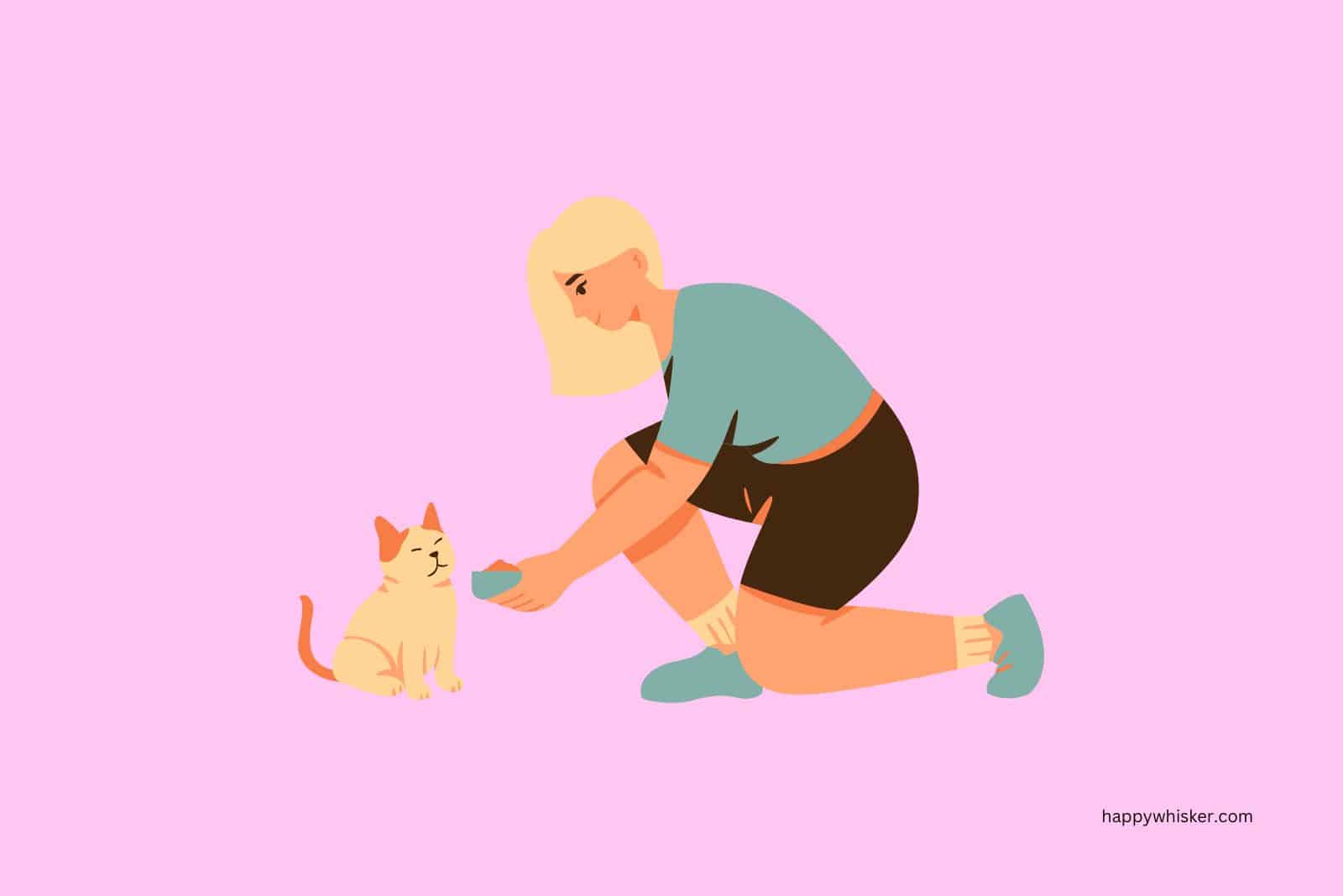15 Tips & Tricks On How To Make A Cat Like You

Meeting a new kitty can be exciting but also a bit intimidating. Getting a cat to like you and earning their trust is not easy to achieve.
Cats are not so open-minded when meeting strangers as, for example, dogs are. It is a good idea to be prepared to meet a new foster cat, a friend’s cat, or a stray cat you are taking in.
With the 15 tips and tricks on how to make a cat like you I’m going to show you, you will surely be successful in earning the cat’s likes and trust! I’ve also prepared pictures for you, and I hope you’ll enjoy them!
How To Make A Cat Like You

The following tips and tricks will work if:
🐾 you’re meeting a new cat for the first time, and you want the cat to like you
🐾 you want to make your cat love you more (these pieces of advice are a bit further on the tips and tricks list!)
Let’s begin!
1. Your Body Language Matters
Making a new cat feel relaxed is key when meeting them for the first time. Given how small cats are in comparison to people, it is crucial that they feel comfortable and not threatened. A cat is more inclined to hide or avoid you if it feels fear.
Cat lovers, the first thing you should do when meeting a new cat, is to kneel and approach the animal at its level. Being tiny makes you less threatening.
Direct eye contact might be seen as hostile or even threatening. Cats don’t like to look directly into your eyes as dogs do because they perceive it as an attempt to frighten them, and they may retaliate by being afraid or hostile.
Avoid gazing into a cat’s eyes, despite how beautiful they might be.
2. Let The Cat Make The First Move
If you’re a huge cat lover, It might be hard to control your impulses around them. You may dash towards a cute cat as soon as you see it, and try to interact, snuggle and cuddle with them.
However, there are better approaches than this when meeting a new cat. Letting the feline take the initiative is the key to winning them over. Maintain your composure and avoid coming across as overly needy for their attention.
Accepting that you no longer have control over the situation is the first step in making a cat like you. Let the cat start the interaction.
Allowing the cat to smell you is the next step. Place your hand on the ground with extended fingers so the cat won’t have to get too near.
Friendly and familiar cats may frequently approach and indulge in some nose-to-nose sniffing. By extending your index finger for the cat to sniff, you can try to do something similar.
Allow the cat to leave if it chooses to. It’s important to allow the cat to decide how the interaction will proceed (or not proceed at all).
3. Try Petting The Cat
To determine whether the cat wants more attention, perform a consent test next. Check whether the cat puts its head against your pointer finger. If it does so, that is a hint that the cat wants to give you more affection.
Cats are incredibly sensitive to touch and prefer some areas of the body petted more than others. Petting the forehead region and the cheeks elicits pleasant reactions from cats, including purring, blinking, and kneading their paws.
The forehead and cheeks are fantastic places to start, especially if you’re meeting a cat for the first time. Of course, every animal is unique, and some cats might not like being petted at all.
You won’t have any trouble recognizing cat cues after you put in a bit of practice.
4. Read The Cues The Cat Is Giving You

The best approach to becoming closer to a cat is to pay attention to its body language and what it likes and doesn’t like, so you can act accordingly.
Positive Cues
If the cat likes you and wants to continue interacting with you, you’ll notice the following signs:
🐾 cat rubbing against you
🐾 cat meowing softly
🐾 rubbing your hand
🐾 nudging you
🐾 pointing the tail upwards and curled
🐾 continuing the interaction and not leaving
The cat may be receptive to cuddling if it brushes against your hand or shows it wants to play by nudging you. The cat is likely showing happiness if it coils its tail around you.
Negative Cues
Pay attention to signs of irritation and give the cat a break if you observe them. Those would be:
🐾 tail swishing
🐾 cranky meows
🐾 growls
🐾 swatting
🐾 turning head away from you
🐾 arched back
🐾 walking away
The cat is indicating it feels frightened if it hisses, growls, swats, or even bites. You may have approached too closely or moved too quickly if any of these behaviors occur. If the cat reacts negatively, it’s evident that it does not want to continue the interaction.
All too frequently, well-intentioned people fail to notice the cat’s early warning body language signals.
Pay attention to the cat’s body language to establish trust and grow a connection. When necessary, back off to prevent the cat from feeling as though they have no other choice than to become aggressive.
5. Don’t Smother The Cat
When petting and playing with a cat, it’s crucial to put the cat’s needs over what you want.
For example, you find the cat adorable and want to continue interacting with it, but the cat doesn’t feel the same. In this case, you must stop smothering the cat.
Some cats are perfectly content to spend most of the day alone, only approaching humans when they need attention, amusement, or food.
Cats strongly demand independence and personal space even though they depend on you for care.
Treating cats like dogs is a common mistake. Unlike dogs, cats are solitary creatures that do not require frequent social engagement.
Don’t take it personally if the cat chooses to ignore you or stop the contact early.
6. Use Treats To Your Advantage
If there’s one thing all cats like, it’s cat treats! Cat treats have strong flavors, vivid aromas, and intriguing textures that most cats cannot resist.
If the cat is hesitant to approach you, gently toss a treat towards the cat, but still close to you. This will get a cat to associate your presence with pleasant things.
Don’t give the cat all the treats at once, but ration them. As soon as the cat discovers how good they taste, it will want more, and considering you’re the source of the treats, the cat will likely approach you.
Truth be told, it will approach you to get more treats, but the cat might start liking you along the way. Bribery may not be such a bad thing after all!
7. Ensure Your Cat Has Everything – Food, Toys, Bed…

This tip and all of the following ones are for cat owners who have moved past the initial introduction to a new cat.
Let’s say you’ve got a new cat, but you feel like the cat could like you a bit more. If this is the case for you, the following tips will surely help!
The first thing you should do is go over this list and see if the answer to each question is yes:
🐾 Do you give your cat enough food?
🐾 Does your cat have constant access to water?
🐾 Does your cat have a cozy place to sleep?
🐾 Does your cat have enough interactive toys?
🐾 Does your cat have a scratching post?
If the answer to any of these questions is no, then I urge you to change that. Cats can display dissatisfaction with something by not giving you attention or affection, which comes off as the cat disliking you.
8. Provide A Stress-Free Environment
One reason why a cat might seem stand-offish towards you is that the cat is stressed.
It can be difficult to recognize a stressed cat in your home, as its behavioral changes are subtle but still noticeable if you pay attention to it.
What could be causing your cat to feel stressed?
The most likely reason is that there’s a change in the cat’s environment, such as the presence of new pets, which leads to competition for resources and litter boxes (even though there’s surely enough for everyone).
It’s critical to recognize the symptoms of stress in cats and try to eliminate them. Stress can cause your cat to become emotionally and physically ill, leading to undesirable behaviors and a stressful period for the cat and the owner.
A stress-free environment makes the cat relaxed, and you can start building a relationship with your cat on a clean slate.
9. Clean The Cat’s Litter Box On Time
Cats are famous for their love of cleanliness. They keep themselves clean daily but cannot clean their litter box – that’s the owner’s job.
If the owner forgets to clean the litter box, that might be an issue for a cat. Many cats show anger and frustration when their litter boxes haven’t been cleaned in a while.
Your cat might not show that it likes you because you don’t regularly clean its litter box.
Luckily, you can fix this issue quickly. It would be best if you cleaned the litter box daily and completely replaced the litter every 3-4 weeks.
However, you don’t have to stick to this rule. You should replace the litter whenever you notice a bad odor or that most of the litter has been used and needs replacing.
Another thing I should mention is that cats don’t like having their litter boxes moved to other parts of the house; find one place for the cat’s litter box and don’t move it around.
Also, don’t switch the type of brand of litter you often use, as cats don’t like change; they’re creatures of habit!
10. Cats Like Their Space To Be Clean
Your cat needs their entire living space to be as neat as possible.
As frequently as possible, clean your cat’s bed, toys, food and water bowls, and other accessories.
Establish a regular cleaning routine and vacuum their favorite areas – preferably while they’re not there – to avoid scaring them with the loud noise.
A clean living environment will enhance your cat’s physical and mental health. Regular cleaning not only gives your cat peace of mind but may also aid with flea prevention.
I’m sure your cat will greatly appreciate what you do and maybe even start liking you more and more!
11. Have Playdates Often
Playtime provides your feline buddy with much-needed cerebral stimulation and satisfies their predatory impulses, regardless of whether you have a big or little cat breed. Additionally, it reduces the symptoms of boredom and undesirable behaviors.
This is why it’s crucial to play with your cat daily and provide them with toys they may chase and pounce on. Cat toys made of feathers, twine, rope, and other materials that simulate prey are great for letting your pet’s natural hunting instincts run wild.
Playtime is not only necessary for your cat to have a healthy, active life, but it will also strengthen your relationship.
You should spend some time socializing with your cat each day and playing with them, especially if they are young.
By doing pleasurable activities with your cat, you may help the cat associate you with good things, making it more likely that it will want to be near you.
12. Provide High-Quality Food

It may be tempting to buy the cheapest cat food you can find at the supermarket, but doing so frequently results in food with poor-quality ingredients that only supply some of the nutrients your cat needs.
When you examine the contents of the cat food, you want to find a more significant proportion of healthy ingredients, such as grains and meat. A more costly diet will typically contain more meat than grains, making it healthier for your cat.
All the essential amino acids are provided by high-quality proteins, including those in meat and fish, so ensure your cat has meat-derived proteins as the main part of its diet.
Trust me, cats can distinguish between high-quality and low-quality food, and if you’re providing them with the best food you can afford, trust me, your kitty will be grateful!
13. Acknowledge That Some Cats Have Issues Trusting Humans
If a cat is not socialized correctly or cared for during its lifetime or as a kitten, the cat might grow to have difficulty trusting humans. This may manifest in the cat not seeking human contact and not displaying affection, which comes across as not liking the owner.
Some cats, especially rescued feral cats, have had serious trauma and are more difficult to win over.
Speaking with an animal behavior expert can be worthwhile to establish a solid relationship with your new pet under these circumstances. They will be able to offer advice on how to approach this issue.
Building a trusting connection with a cat who struggles with trust takes time and effort. A cat’s trust is a prized possession that must be earned, but it is well worth the effort.
14. Never Resort To Punishment
Although I’m sure most of my readers know that they should never resort to punishing their cats for whatever they might have done, I need to mention it briefly.
Cats tend to flee when disciplined with screaming or other violent behaviors. They typically do not learn through punishment.
Water spraying is a frequent method of correcting a cat’s undesirable behavior, but it might make the cat dread and not trust you. If you’re a cruel owner, your cat won’t like you, and that’s the bottom line.
15. Embrace Your Cat’s Personality
A 2019 study of behavioral differences of different cat breeds described the differences in personality traits, once again proving that a cat’s personality is dependent (but not entirely) on the cat’s breed.
The study revealed that the least likely to seek out human interaction were British Shorthair cats, while the most likely to do so were Korat and Devon Rex cats.
Why am I mentioning this?
Some cats are not prone to displaying affection, which can come across as the cat not liking you.
If you have a cat whose personality trait is not being extra-cuddly, it doesn’t mean the cat does not like you – it’s simply how your cat is!
How Do I Tell If A Cat Likes Me?

If you’ve tried every tip and trick mentioned above, you might be wondering, How do I know if a cat likes me now? Luckily, the cues are easy to notice!
Cats display their affection in a variety of ways. Their actions, body language, and vocalizations frequently reveal how much they value and trust us. It’s simply up to you to notice them!
Kneading
If a cat is using your lap to knead on, that proves the cat likes you! Cats only display this cat behavior when they feel safe, content, and they trust the person. Whenever a kitty decides to knead on you, think of it as the cat’s way of saying “I love you!”
Following You Around
Cats frequently follow individuals they love and trust around the house. They follow you and keep you in their view at all times. This is adorable, isn’t it?
Headbutting
To express affection, your cat may brush its face against you or bump its head against you. Kittens do this to their mother and other kittens as well!
Meowing
Even a cat’s meow may indicate affection. When you arrive home, your cat might greet you with a joyful meow and then meow at you more urgently when he needs your attention.
Licking Your Face
Licking your face is one of the ways cats express their affection for you! Some people like this, while others do not, but one thing is sure – cats only lick the faces of people they like!
Looking At You And Purring
Cats gaze directly into the eyes of individuals they love and trust to express their admiration for them. If you notice a cat’s slow blinks and purrs in your direction, there is no question about it – that cat likes you very much!
Sleeping Next To You
A cat will choose to sleep on you or close to you as a sign of its love and trust for you. Even if they prefer to lie just out of reach for caressing, they feel secure in the knowledge that you will protect them in case of harm or that you will protect them if you are in danger.
Showing You Their Belly
This is frequently regarded as the pinnacle of a cat’s trust behavior. Cats only display their bellies when they are calm, lying on their backs.
However, please don’t pet or stroke your cat’s tummy! Most cats hate belly rubs!
A Cat’s Tail Never Lies
A happy cat will frequently hold its tail upright in a “C-shape”. When they are resting close to you, they could let their tail gently wag back and forth and touch you. When they are overjoyed to meet you, they occasionally vibrate their tails while walking.
Wrapping Up

Now you know how to make a cat like you! With these 15 tips and tricks, I’m sure you’ll have no problems meeting a new cat and getting them to like you or having your new cat like you even more!
There’s no better feeling than having a kitty approach you on its own and ask for your attention. Therefore, I’m sure many people are eager to learn how to make a good impression on felines!
Pet parents, remember to be patient; earning a cat’s trust is never easy, but once you succeed, it’s very rewarding!
Related Articles:
Why Does My Cat Grab My Hand And Bite Me: 8 Reasons
Why Does My Cat Attack Me And No One Else – 7 Reasons & Fixes






